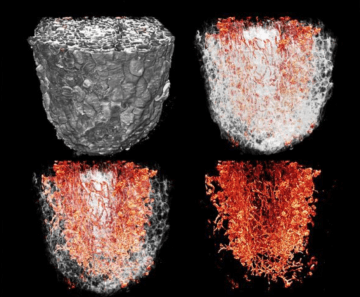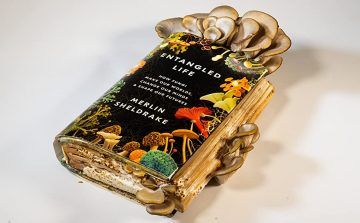https://www.3quarksdaily.com/3quarksdaily/2020/08/life-distributed.html
by Ashutosh Jogalekar

One of my favorite science fiction novels is “The Black Cloud” by Fred Hoyle. It describes an alien intelligence in the form of a cloud that approaches the earth and settles by the sun. Because of its proximity to the sun the cloud causes havoc with the climate and thwarts the attempts of scientists to both study it and attack it. Gradually the scientists come to realize that the cloud is an intelligence unlike any they have encountered. They are finally successful in communicating with the cloud and realize that its intelligence is conveyed by electrical impulses moving inside it. The cloud and the humans finally part on peaceful terms.
Our intelligence is locked up in a three pound mass of wet solid matter. And it’s a result of the development of the central nervous system. The central nervous system was one of the great innovations in the history of life. It allowed organisms to concentrate their energy and information-processing power in a single mass that sent out tentacles communicating with the rest of the body. The tentacles are important but the preponderance of the brain’s capability resides in itself, in a single organ that cannot be detached or disassembled and moved around. From dolphins to tigers and from bonobos to humans, we find the same basic plan existing for good reasons. The central nervous system is an example of what’s called convergent evolution, which refers to the ability of evolution to find the same solutions for complex problems. Especially in Homo sapiens, the central nervous system and the consequent development of the neocortex are seen as the crowning glory of human evolution.
And yet it’s the solutions that escaped the general plan that are the most interesting in a sense. Throughout the animal and plant kingdom we find examples not of central but of distributed intelligence, like Hoyle’s cloud. Octopuses are particular fascinating examples. They can smell and touch and understand not just through their conspicuous brains but through their tentacles; they are even thought to “see” color through these appendages. But to find the ultimate examples of distributed intelligence, it might be prudent not to look at earth’s most conspicuous and popular examples of life but its most obscure – fungi. Communicating the wonders of distributed intelligence through the story of fungi is what Merlin Sheldrake accomplishes in his book, “Entangled Life”.

Fungi have always been our silent partners, partners that are much more like us than we can imagine. Like bacteria they are involved in an immense number of activities that both aid and harm human beings, but most interestingly, fungi unlike bacteria are eukaryotes and are therefore, counterintuitively, evolutionarily closer to us rather than to their superficially similar counterparts. And they get as close to us as we can imagine. Penicillin is famously produced by a fungus; so is the antibiotic fluconazole that is used to kill other fungal infections. Fungal infections can be deadly; Aspergillus forms clumps in the lungs that can rapidly kill patients by spreading through the bloodstream. Fungi of course charm purveyors of gastronomic delights everywhere in the world as mushrooms, and they also charm purveyors of olfactory delights as truffles; a small lump can easily sell for five thousand dollars. Last but not the least, fungi have taken millions of humans into other worlds and artistic explosions of colors and sight by inducing hallucinations.
The mycorrhizal networks that wind their way in and out of tree roots are likely as old as trees themselves. The alliance almost certainly exists because of a simple matter of biochemistry. When plants first colonized land they possessed the miraculous ability of photosynthesis that completely changed the history of life on this planet. But unlike carbon which they can literally manufacture out of sunlight and thin air, they still have to find essential nutrients for life, metals like magnesium and other life-giving elements like phosphorus and nitrogen. Because of an intrinsic lack of mobility, plants and trees had to find someone who could bring them these essential elements. The answer was fungi. Fungal networks stretching across miles ensured that they could shuttle nutrients back and forth between trees. In return the fungi could consume the precious carbon that the tree sank into its body – as much as twenty tons during a large tree’s lifetime. It was the classic example of symbiosis, a term coined by the German botanist Albert Frank, who also coined the term mycorrhiza. https://lockerdome.com/lad/12548422440029798?pubid=ld-dfp-ad-12548422440029798-0&pubo=https%3A%2F%2Fwww.3quarksdaily.com&rid=www.inoreader.com&width=724
This intelligent long-distance relay gets mirrored in the behavior of the trees that the fungi form a mind meld with. One of the characters in Richard Powers’s marvelous novel “The Overstory” discovers how trees are whispering hidden signals to each other, not just through fungal networks but through ordinary chemical communication. The character Patty Westford finds out that when insects attack one tree, it can send out a chemical alarm that alerts trees located even dozens of meters away of its plight, causing them to kick their own repellant chemical production into high gear. Meeting the usual fate of scientists with novel ideas, Westford and her ideas are first ignored, then mocked and ostracized and ultimately grudgingly accepted. But the discovery of trees and their fungal networks communicating through each other and through the agency of both chemicals and other organisms like insects is now generally accepted enough to become part of both serious scientific journals and prizewinning novels.
Fungi can also show intelligent behavior by manipulating our minds, and this is where things get speculative. Psilocybin and LSD have been used by shamans, hippies and Silicon Valley tech entrepreneurs over thousands of years. When you are familiar with both chemistry and biology it’s natural to ask what might be the perceived evolutionary utility of chemical compounds that bring about changes in perception that are so profound and seemingly liberating as to lead someone like Aldous Huxley to make sure that he was on a psychedelic high during the moment of his death. One interesting clue arises from the discovery of these compounds in the chemical defense responses of certain fungi. Clearly the microorganisms that are engaged in a war with fungi – and these often include other fungi – lack a central nervous system and have no concept of a hallucination. But if these compounds are found as part of the wreckage of fungal wars, maybe this was their original purpose, and the fact that they happen to take humans on a trip is only incidental.
It is all too easy to anthropomorphize trees and especially fungi, which only indicates how interestingly they behave. One can say that “trees give and trees receive”, “trees feel” and even “trees know”, but at a biological level is this behavior little more than a series of Darwinian business transactions, purely driven by natural selection and survival? Maybe, but ultimately what matters is not what we call the behavior but the connections it implies. And there is no doubt that fungi, trees, octopuses and a few other assorted creatures are displaying a unique type of intelligence that humans may have merely glimpsed. Distributed intelligence clearly has a few benefits over a central, localized one. Unlike humans who are unlikely to live when their heads are cut off, newts can regrow their heads when they get detached, so there’s certainly a survival advantage conferred by not having your intelligence organ be one and done. This principle has been exploited by the one form of distributed intelligence that is an extension of human beings and that has taken over the planet – the Internet. Among many ideas that are regarded as the origins of the Internet, one was conceived by the defense department which wanted to built a communications net that would be resilient in the face of nuclear attack. Having a distributed network with no one node being a central node was the key. Servers in companies like Google and Facebook are also constructed in such a way that a would be hacker or terrorist would have to take out several and not just a few in order to measurably impair the fidelity of the network.
I also want to posit the possibility that distributed systems might be more analog than central ones and therefore confer unique advantages. Think of a distributed network of water pipes, arteries, traffic lanes or tree roots and fungal networks and one has the image in mind of a network that can almost instantaneously transmit changes in parameters like pressure, temperature and density taking place in one part of the network to another. These are all good examples of analog computation, although in case of arteries, the analog process is built on a substrate of digital neuronal firing. The human body is clearly a system where a combination of analog and digital works well, but looking at distributed intelligence one gets a sense that we can optimize our intelligence significantly using more analog computing.
There is no reason why intelligence may not be predominantly analog and distributed so that it becomes resilient, sensitive and creative like mycorrhizal networks, being able to guard itself against existential threats, respond to new food and resource locations and construct new structures with new form and function. One way to make human intelligence more analog and distributed would be to enable human-to-human connections through high-fidelity electronics that allows a direct flow of information to and from human brains. But a more practical solution might be to enable downloading brain contents including memory into computers and then allowing these computers to communicate with each other. I do not know if this advance will take place during my lifetime, but it could certainly bring us closer to being a truly distributed intelligence that just like mycorrhizal networks is infinitely responsive, creative, resilient and empathetic. And then perhaps we will know exactly what it feels like to be a tree.